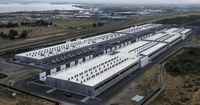Electricity prices in the United States have surged in recent years, igniting a fierce political debate over the causes and solutions. President Donald Trump has squarely blamed renewable energy sources—specifically wind and solar—for what he calls “record breaking increases in electricity and energy costs,” labeling them “THE SCAM OF THE CENTURY!” in a series of posts on his Truth Social platform. But a closer look at the data and expert analysis reveals a far more complicated picture, one in which renewables may not be the culprit Trump claims—and in which the nation’s aging power grid, extreme weather, rising natural gas prices, and ballooning demand all play starring roles.
Since May 2019, the average U.S. residential electricity price has climbed from about 10.5 cents per kilowatt-hour to more than 13 cents by May 2025, representing a 27% increase, according to the U.S. Energy Information Administration and analysis reported by Heatmap. The largest leap occurred in 2022, when prices jumped from 11 cents at the end of 2021 to well over 13 cents by August 2022. Over the past year alone, electricity prices have risen 5.5%, outpacing the overall inflation rate of 2.7%.
President Trump’s criticism of renewables comes at a politically sensitive time. During his 2024 campaign, he pledged to cut Americans’ electricity bills in half during his first year in office. “Your electric bill—including cars, air conditioning, heating, everything, your total electric bill—will be 50% less. We’re going to cut it in half,” he promised. Now, halfway through his term, prices have instead continued to climb, and Trump has shifted his focus to blaming wind and solar projects. “The days of stupidity are over in the USA!!!” he wrote, vowing to oppose new wind or “farmer destroying Solar” initiatives.
However, energy analysts and industry experts dispute the notion that renewables are driving up electricity costs. According to the Associated Press, most experts point instead to a combination of factors: increased demand (especially from energy-hungry data centers and a growing fleet of electric vehicles), the need for costly upgrades to an aging grid, and the impact of increasingly extreme weather events—like wildfires and hurricanes—that damage infrastructure and drive up insurance and rebuilding costs.
Natural gas, which still generates more than 40% of U.S. electricity, has also seen prices spike, largely due to increased exports to Europe and other international buyers. When natural gas prices soar, utilities often pass those costs directly to consumers. This dynamic was particularly acute in 2022, when American natural gas prices rose more than 140% amid surging global demand.
Meanwhile, the cost of maintaining and upgrading the nation’s vast network of poles, wires, transformers, and substations has ballooned. Spending on distribution infrastructure—essentially the “last mile” that brings power to homes and businesses—has nearly doubled since 2019, according to a Lawrence Berkeley National Laboratory report cited by Heatmap. Some of these costs are due to utilities replacing aging equipment; others stem from efforts to harden the grid against disasters or to connect new suburban developments.
In fact, analysis from Energy Innovation, a non-partisan think tank, and the U.S. Energy Information Administration shows there is no clear relationship between a state’s reliance on renewable energy and the pace of its electricity price increases. States like North Dakota and Iowa, which get a significant share of their power from wind, have seen electricity prices rise more slowly than the national average—or even fall. “Many of the states with the largest increases in wind and solar generation since 2010—including Iowa, New Mexico, Kansas, and Oklahoma—have seen rates rise slower than inflation,” Energy Innovation found.
There are outliers. California and Maine, both with high shares of renewables, have seen sharp price increases. But in California, wildfire-related costs and utility bankruptcies have played a major role, while in Maine, volatility in natural gas prices has been a bigger factor than solar incentives, according to reporting by Heatmap and Canary Media. Isolated states like Hawaii and Alaska also tend to have higher prices, regardless of their energy mix, due to their unique grid challenges.
Despite the rhetoric, renewables are booming. More than 90% of new U.S. electricity generation capacity added in 2024 was from clean sources, and in 2025, over half of the 64 gigawatts of planned new capacity will come from solar, with another 18 gigawatts from battery storage and 8 gigawatts from wind, according to the Energy Information Administration. Advocates argue that renewables are not only clean but also among the cheapest and fastest ways to add power to the grid. “The real scam is blaming solar for fossil fuel price spikes,” the Solar Energy Industries Association retorted in response to Trump’s accusations. “Farmers, families, and businesses choose solar to save money, preserve land, and escape high costs of the old, dirty fuels being forced on them by this administration.”
Jason Grumet, CEO of the American Clean Power Association, pointed to government data showing that states with the highest share of clean energy production have actually seen electricity prices decline in the past year. “By slowing clean energy deployment, the Trump administration is directly fueling cost increases,” he said. Ted Kelly of the Environmental Defense Fund added, “Blocking cheap, clean energy while doubling down on outdated fossil fuels makes no economic or environmental sense.”
Partisanship continues to shape the debate. Democrats have blamed Trump for rising prices, citing his administration’s efforts to restrict clean energy incentives through recent tax-and-spending cuts and new regulations. A report from Energy Innovation found that the GOP-backed tax law will increase the average family’s energy bill by $130 annually by 2030, primarily by phasing out clean energy tax credits and complicating material sourcing requirements for new projects. John Quigley of the Kleinman Center for Energy Policy warned that these policies could eliminate as many as 45,000 jobs by 2030 and slow the construction of solar, wind, and battery projects.
Not all Republicans are on board with Trump’s approach. Iowa Senator Chuck Grassley, a longtime wind power supporter, has advocated for a gradual phase-out of renewable tax credits rather than an abrupt end, saying that recent Treasury guidance “seems to offer a viable path forward for the wind and solar industries to continue to meet increased energy demand.”
Even Trump’s own Energy Secretary, Chris Wright, acknowledged the complexity of the situation, telling POLITICO, “That momentum is pushing prices up right now. And who’s going to get blamed for it? We’re going to get blamed because we’re in office.”
Looking ahead, experts warn that the real challenge is meeting surging demand—driven by data centers, electric vehicles, and new factories—while upgrading an aging grid and adapting to a changing climate. As utilities race to build new power plants, transmission lines, and infrastructure, the costs will likely continue to rise. And unless policymakers address the true drivers of these increases, the political blame game over renewables may only intensify, leaving consumers caught in the middle.


